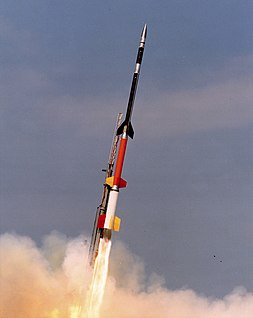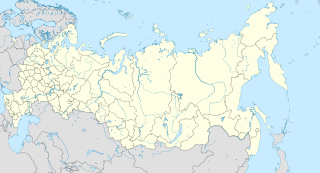
Animal Farm is an allegorical novella by George Orwell, first published in England on 17 August 1945. According to Orwell, the fable reflects events leading up to the Russian Revolution of 1917 and then on into the Stalinist era of the Soviet Union. Orwell, a democratic socialist, was a critic of Joseph Stalin and hostile to Moscow-directed Stalinism, an attitude that was critically shaped by his experiences during the Spanish Civil War. The Soviet Union, he believed, had become a brutal dictatorship, built upon a cult of personality and enforced by a reign of terror. In a letter to Yvonne Davet, Orwell described Animal Farm as a satirical tale against Stalin, and in his essay "Why I Write" (1946), wrote that Animal Farm was the first book in which he tried, with full consciousness of what he was doing, "to fuse political purpose and artistic purpose into one whole".
Spetsnaz is an umbrella term for special purpose in Russian and is used in numerous post-Soviet states.
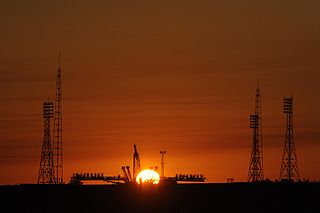
The Baikonur Cosmodrome is a spaceport located in an area of southern Kazakhstan leased to Russia.

Roman Arkadyevich Abramovich is a Russian billionaire businessman, investor and politician.

Israel Moiseevich Gelfand, also written Israïl Moyseyovich Gel'fand, or Izrail M. Gelfand was a prominent Soviet mathematician. He made significant contributions to many branches of mathematics, including group theory, representation theory and functional analysis. The recipient of many awards, including the Order of Lenin and the Wolf Prize, he was a Fellow of the Royal Society and professor at Moscow State University and, after immigrating to the United States shortly before his 76th birthday, at Rutgers University.

Ronnie Dean Coleman is an American retired professional bodybuilder. The winner of the Mr. Olympia title for eight years in a row, he is widely regarded as one of the greatest bodybuilders of all time. Alongside his eight Mr. Olympia wins, he held the record for most wins as an IFBB professional with 26 titles.

The MT-LB is a Soviet multi-purpose fully amphibious auxiliary armored tracked vehicle, which was first introduced in the 1950s. It is also produced in Poland, where its YaMZ engine replaced by Polish one.

The Project 1241 are a class of Soviet missile corvettes. They have the NATO reporting name Tarantul. These ships were designed to replace the Project 205 Tsunami missile boats.

The Russian Air Force is a branch of the Russian Aerospace Forces, the latter being formed on 1 August 2015 with the merger of the Russian Air Force and the Russian Aerospace Defence Forces. The modern Russian Air Force was originally established on 7 May 1992 following Boris Yeltsin's creation of the Ministry of Defence; however, the Russian Federation's air force can trace its lineage and traditions back to the Imperial Russian Air Service (1912–1917) and the Soviet Air Forces (1918–1991).

The MR-UR-100 Sotka was a MIRV-warhead intercontinental ballistic missile (ICBM) developed and deployed by the Soviet Union from 1978 to 1993. The missile was given the NATO reporting name SS-17 Spanker and was built under the Soviet industry designation 15A15. An alternative designation for the missile is the UR-100MR.
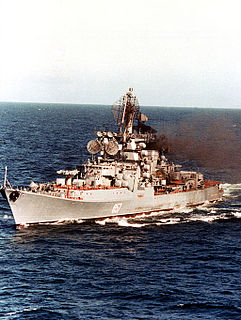
The Kresta II-class, Soviet designation Project 1134A Berkut or Berkut A, was a class of guided missile cruisers built by the Soviet Union for the Soviet Navy. The ships entered service between the late 1960s and 1970s and were decommissioned after the end of the Cold War. They were built by the Zhdanov Yard, Leningrad.

The KSVK or Degtyarev sniper rifle is a 12.7mm anti-materiel sniper rifle developed in Russia for the purpose of counter sniping and penetrating thick walls, as well as light armored vehicles.
Taifun 9M15 (typhoon) was a Soviet missile developed to arm the Obiekt 287 missile tank based on the T-64 tank chassis. The tank was armed with two 73 mm 2A28 low pressure guns mounted either side of a popup missile launcher. Both the guns and the missile launcher were automatically loaded, the guns each being fed from two eight round drums, giving a total of 32 guns rounds and 15 missiles stored in the tank. The missile launch platform was vertically stabilised, allowing the vehicle to move at low speed and fire. The guns were remotely controlled by the gunner and commander from the front of the hull.

The Kh-25/Kh-25M is a family of Soviet lightweight air-to-ground missiles with a modular range of guidance systems and a range of 10 km. The anti-radar variant (Kh-25MP) is known to NATO as the AS-12 'Kegler' and has a range up to 40 km. Designed by Zvezda-Strela, the Kh-25 is derived from the laser-guided version of their Kh-23 Grom. It has now been succeeded by the Kh-38 family, but the Kh-25 remains in widespread use.
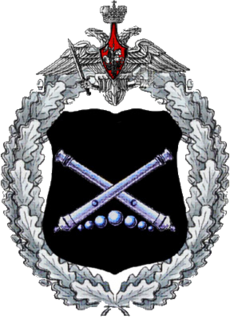
The Main Missile and Artillery Directorate of the Ministry of Defense of the Russian Federation (GRAU) is a department of the Russian (ex-Soviet) Ministry of Defense. It is subordinate to the Chief of Armament and Munition of the Russian Armed Forces, a vice-minister of defense.

Spektr-R is a Russian scientific satellite with a 10 m (33 ft) radio telescope on board. It was launched on 18 July 2011, by Zenit-3F launcher, from Baikonur Cosmodrome to perform research on the structure and dynamics of radio sources within and beyond our galaxy. Together with some of the largest ground-based radio telescopes, this telescope forms interferometric baselines extending up to 350,000 km (220,000 mi).

GLONASS-M, also known as Uragan-M are the second generation of Uragan satellite design used as part of the Russian GLONASS radio-based satellite navigation system. Developed by ISS Reshetnev, it had its debut launch in 2003, and is in the process of being phased out. Its production is expected to finish in 2015 and as of July, 2015, its last launch was expected in late 2017. It is an evolution of the previous Uragan second-generation satellites, improving accuracy, increasing power, extending the design life and adding the FDMA L2OF open signal. The last eight Glonass-M spacecraft in production include the new CDMA L3OC open signal.

The Sovremenny-class destroyer is a class of anti-surface warship of the Soviet and later Russian Navy. The Soviet designation for the class was Project 956 Sarych (Buzzard), while the NATO designation derives from the name of the lead ship, Sovremenny. The ships are named after qualities, with "Sovremenny" translating as "modern" or "contemporary". Most of the ships have been retired from active service, though several remain in commission with the Russian Navy, either in reserve or undergoing overhaul. Another is a museum ship. Four modified ships were delivered to the People's Liberation Army Navy, and remain in service.

Luna 27 is a planned lunar lander mission by the Russian Federal Space Agency (Roscosmos) with collaboration by the European Space Agency (ESA) to send a lander to the South Pole–Aitken basin, an area on the far side of the Moon. Its objective will be to detect and characterise lunar polar volatiles. The mission is a continuation of the Luna-Glob programme.
Spektr-M is a proposed Russian scientific satellite with a 10 m (33 ft) sub-millimeter to far infra red space telescope. It is designed to be a successor to the Herschel Space Observatory, covering similar wave bands. It is designed to look into chemical evolution in the universe, black hole horizon radiation, and dark energy investigation.
